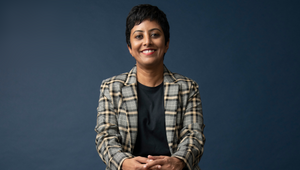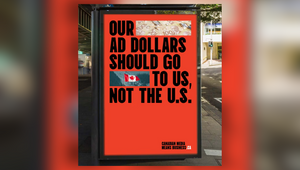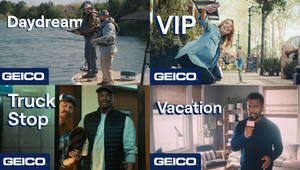
In Conversation with Schiefer Chopshop’s Jeff Roach

Jeff Roach is the president and CSO of Californian media and creative agency Schiefer Chopshop (the agency is the birth child of a merger between Chopshop and Schiefer Media). He’s channeled many roles during his career, starting out as a graphic designer after learning the ropes making posters for his band Arizona Rain, account management and strategy.
We caught up with him to pick his brains.
Q> What are your first memories about advertising? When did you start taking an interest in it?
A> I was 20 years old and in a band called Arizona Rain and I was known for having creative band posters promoting our shows which I was making at Kinko’s, cutting-and-pasting on a photocopier. A friend in another band showed me how to do the same kind of work in QuarkXpress. It didn’t take long before I was freelancing as a graphic designer for other bands, and ultimately started working for a small design shop on branding, packaging design and other retail work.
Q> When did you that turn into thinking you could make a career of it?
A> As I began freelancing as a designer for small agencies I was eventually hired by one of them as their creative studio manager due to both my design understanding but my ability to deal with a lot of balls in the air at one time. I learned that although I loved the world of design (and still do), that marketing planning and technology was what I excelled at. After learning how to code basic websites early on, I launched a small digital agency in 1999 within the design shop I was at and started expanding my horizons as an agency marketer, learning the craft of essentially all sides of marketing communications. It took me years to understand the politics of the business and how to succeed at getting big ideas appropriately sold in.
Q> Prior to your role at Schiefer Chopshop, you were at Fuel Industries - how did you get into the strategic side of the business?
A> It wasn’t until I landed at a youth marketing agency in 2003 called Youthography that I truly discovered what it meant to be a strategist and account planner. I helped Youthography launch their creative agency arm – with a lot of collaboration from Creative Director partner, Sean Claessen – and we were able to connect insights to marketing execution so successfully that we won major business from Fortune 500’s like GM, P&G, Microsoft, MTV and Cadbury. I discovered the power of strategy to not only create better work, but more importantly for providing value to clients by being an expert on their consumer. Under Youthography’s founder Max Valiquette, I learned how to focus strategic planning for a brand and the power of combining pop culture with specific consumer insights as a planning framework. I was recruited in to Fuel as Chief Strategy Officer in 2011 by Mike Burns (Founder, Co-CEO & CCO) who was a brilliant ‘big-idea creative’ in tech, and he gave me the opportunity to bring that approach to planning on global digital business for McDonald’s, Coca-Cola, NASCAR, Warner Bros. and others. It was an incredible opportunity to focus entirely on digital engagement and think broadly about consumer insights and strategic planning in a world going social and mobile. It allowed me to expand my thinking as to the kind of insights strategic planners need to look at, like digital metrics and global culture, while also focusing on new digital product tactics like gamification, augmented reality, and the benefits these new digital tools could provide to brands.
Q> What has SCS’s growth been like since the merger between Chopshop and Schiefer Media?
A> Quite simply, it’s been crazy. We merged these two small shops together and on start-up we worked through what we felt a new agency needed to be – insights-led, data-driven, integrated, nimble, collaborative – and then got flooded in work and needed to focus on delivering for our (many new) clients. We’ve had to be highly adaptable and to really lean in to our clients and the work they’ve needed us to do. We have an amazing team at SCS as well as an awesome group of really smart clients who believe in our agency and our people. I love going to work every day because I get to do the best work of my career with people who inspire me.
Q> What are some of the transformations you’ve seen as the agency has grown through this merger, and the lessons learned?
A> I think transformation-wise, any agency that grows from small-to-mid knows the pains of building systems and processes that are necessary to manage scale. Although we have great systems in place now, we learned a lot about what that takes and how important the people part of that is. Implementing an enterprise-wide project management software system is nothing without people who believe in the tools and who are willing to work together to make processes work. We’re working to ensure that, as our agency gets larger, we’re also focusing on the ‘small’ as well, giving people the opportunities to work in small teams and to encourage pairs and groups in working relationships throughout the agency, and this even includes the senior team at the executive level. The real innovation will always be found in these small teams and I hope that we will continue to value this in the agency as we grow.
Q> How do you leverage your strategy role to add value to customers/viewers lives?
A> This is a great question because I think some agencies are so often focused on new customer acquisition for clients, that they can miss the existing customer’s needs. If we truly can focus on customers and consumers problems, we will find stronger solutions for our clients and ultimately build more valuable brands. On a strategy level, one of the tools I’m a fan of is the Blue Ocean Strategy framework, by W. Chan Kim & Renée Mauborgne. These professors at INSEAD came up with a very simple way of defining what a customer or consumer would actually care about and make that central to the brand planning process. The idea here is that by mapping what customers really value or need, and then seeing where your brand falls on that map vs your competitors, you can visually get a sense as to where the opportunity for the brand is. It’s an incredible tool, and because it focuses entirely on what consumers value, it ensures that you are coming at the brand from the customer point-of-view. Ultimately, this can lead to what they call the ‘blue ocean’, essentially disruptive brand offerings that remove themselves from the competitive ‘red ocean’ (the blood in the water from competition) and provide a whole new uncontested arena for the brand. It’s a fascinating and effective framework, and it ensures that we are thinking about how to add value to customers lives in our work.
Q> What have you recently been most proud to work on? And what was it that specifically made it work?
A> I’m really proud of the work we’ve done on Boost Mobile for Sprint in the last year. When we won the business in Fall of 2016, the brand was in decline over two years of heavy competition and massive advertising weights from MetroPCS and Cricket Wireless, resulting in hundreds of thousands customers lost for Boost. After launching a really fun campaign for Boost called ‘We Are Where You At,’ we only just slowed the bleeding and we needed to really think differently about the brand if we were going to succeed. We went back to the drawing board and went as deep as we possibly could on a strategic planning and consumer insights level. What we discovered was the simple truth in that every prepaid wireless consumer feels somewhat burned by their carrier and they are tired of the cynicism in the category. Looking at the brand tone for MetroPCS, Straight Talk, Simple Mobile and others it was really negative and combative advertising due to just what a competitive price-point driven all-out knife fight this category had become. And consumers were sort of paying the price, they weren’t happy. So we really keyed in on these insights and we worked to develop specific brand devices around each insight. Negative and combative ads from the competitors? We introduced Grant & Gina, fun and friendly Boost Mobile store employees who are just there to help and would never speak badly about anyone. Expensive plans when the service is essentially parity? We introduced a new tag line: Easy to Switch, Easy to Save. And then we worked to personify our CTA… we want you to switch to Boost, so we created a physical “Switch” that visualized what we wanted customers to do. The strategy behind these new brand devices were so tuned-in to specific consumer insights that the campaign was a resounding success. We have moved the needle on every brand metric we measured, and have brought back those hundreds of thousands of customers that the brand had lost, plus many, many more… and we did it in a very short amount of time – months, not years. We now have one of the most loyal customer audiences in the category. The category is as competitive as ever, but we’re proud of this work due to how strategically grounded it is… it’s proof that our insights-led, data-driven, integrated approach can lead to harder working advertising.
Q> What are your thoughts generally on where the industry’s heading? It’s an interesting time as there are people who are quite frustrated with the state of the industry and others who see a lot of opportunity. I was wondering what side of things you fall on?
A> This industry seems to love a crisis. I’ve been hearing about the death of the agency for over 20-years now, it’s getting tired. Every year we get some self-proclaimed knowledge leader who doesn’t seem to offer much beyond being the new boy-who-cried-wolf. For me it’s just noise and I try not to allow it to affect my work on a day-to-day perspective. Business and marketing will always be changing because that’s what marketing is – competitiveness and the drive to make money by chasing an always moving consumer simply feeds change, that’s the one constant that we have. As a planner, this is the thing that you do, you track consumer change and customer behaviour and you help brands connect with those changes every single day, no matter where they take you. You are seeing consumer behaviour change in real-time and you’re helping your clients adjust to that change quickly. The big difference for us today is just the speed of that change and the amount of data touchpoints now available to us. 20-years ago we would be scratching our heads with our clients, trying to figure out where we were going to get the data from. Now, it’s the opposite. Everyone is drowning in data and clients want to know which data sets we should be paying attention to. Either way, we still have to get to the real insights that will impact the business, so for us it feels like it’s the same game, different problem.















